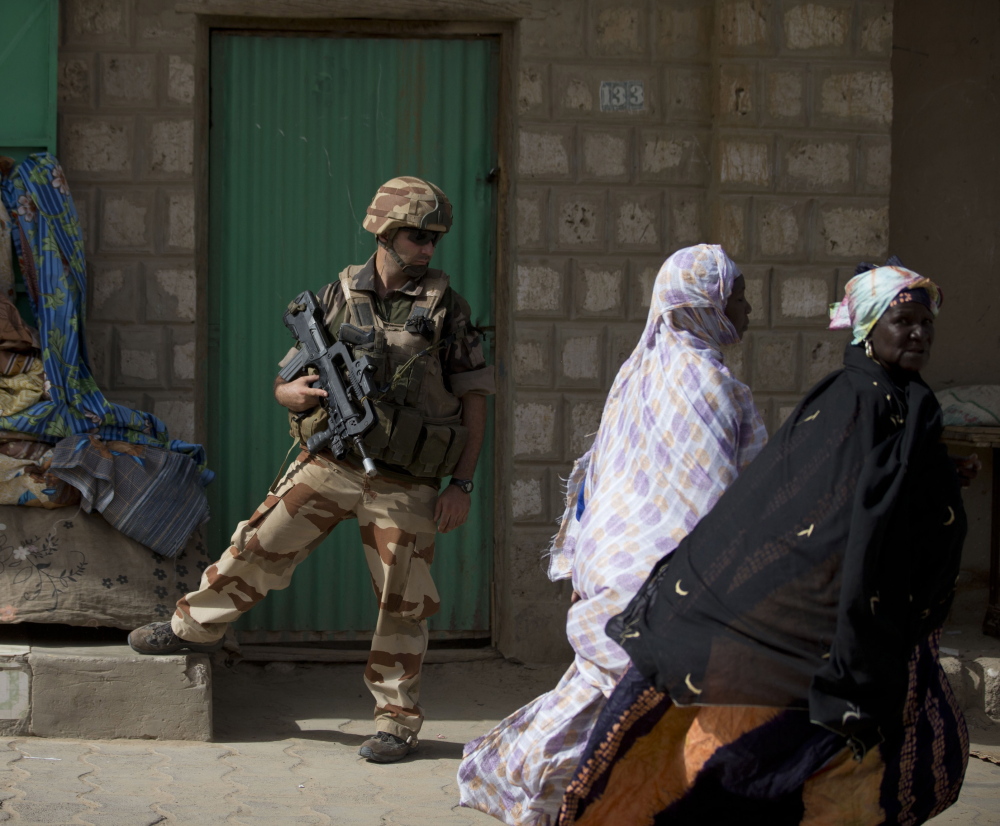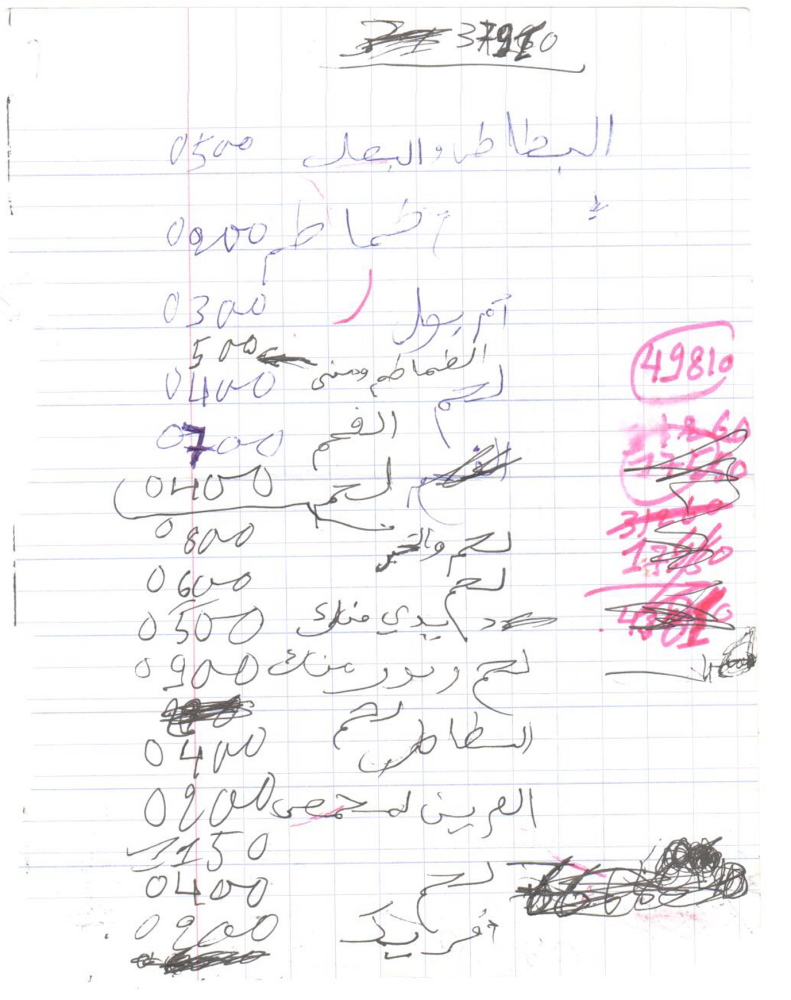TIMBUKTU, Mali — The convoy of cars bearing the black al-Qaida flag came at high speed, and the manager of the modest grocery store thought he was about to get robbed.
Mohamed Djitteye rushed to lock his till and cowered behind the counter. He was dumbfounded when instead, the al-Qaida commander gently opened the grocery’s glass door and asked for a pot of mustard. Then he asked for a receipt.
Confused and scared, Djitteye didn’t understand. So the jihadist repeated his request. Could he please have a receipt for the $1.60 purchase?
This transaction in northern Mali shows what might seem an unusual preoccupation for a terror group: Al-Qaida is obsessed with documenting the most minute expenses.
In more than 100 receipts left in a building occupied by al-Qaida in the Islamic Maghreb in Timbuktu this year, the extremists assiduously tracked their cash flow, recording purchases as small as a single light bulb. The often tiny amounts are carefully written out in pencil and colored pen on scraps of paper and Post-it notes: The equivalent of $1.80 for a bar of soap; $8 for a packet of macaroni; $14 for a tube of super glue. All the documents were authenticated by experts.
The accounting system on display in the documents is a mirror image of what researchers have discovered in other parts of the world where al-Qaida operates, including Afghanistan, Somalia and Iraq. The terror group’s documents around the world also include corporate workshop schedules, salary spreadsheets, philanthropy budgets, job applications, public relations advice and letters from the equivalent of a human resources division.
Taken together, the evidence suggests that far from being a fly-by-night, fragmented terror organization, al-Qaida is trying to behave like a multinational corporation, with what amounts to a company-wide financial policy across its different chapters.
The picture that emerges from what is one of the largest stashes of al-Qaida documents to be made public shows a rigid bureaucracy, replete with a chief executive, a board of directors and departments such as human resources and public relations. Experts say that each branch of the terror group replicates the same corporate structure, and that this strict blueprint has helped al-Qaida not just to endure but also to spread.
AL-QAIDA’S GROCERY LIST
Among the most revealing documents are the receipts, which offer a granular view of how al-Qaida’s fighters lived every day as well as its larger priorities.
“For the smallest thing, they wanted a receipt,” said 31-year-old Djitteye, who runs the Idy Market in Timbuktu. “Even for a tin of Nescafe.”
An inordinate number of receipts are for groceries, suggesting a diet of macaroni with meat and tomato sauce, as well as large quantities of powdered milk. There are 27 invoices for meat, 13 for tomatoes, 11 for milk, 11 for pasta, seven for onions, and many others for tea, sugar and honey.
Keeping close track of expenses is part of al-Qaida’s DNA, say multiple experts, including FBI agents who were assigned to track the terror group in the years just after its founding.
This habit, they say, can be traced back more than three decades to when a young Osama bin Laden entered King Abdul Aziz University in Saudi Arabia in 1976 to study economics, and went on to run part of his millionaire father’s construction company.
After he was exiled to Sudan in 1992, bin Laden founded what became the country’s largest conglomerate. His companies and their numerous subsidiaries invested in everything from importing trucks to exporting sesame, white corn and watermelons. From the get-go, bin Laden was obsessed with enforcing corporate management techniques on his more than 500 employees, according to al-Qaida expert Lawrence Wright, author of a well-known history of the terror group. Workers had to submit forms in triplicate for even the smallest purchases – the same requirement bin Laden later imposed on the first al-Qaida recruits, he said.
In Afghanistan, detailed accounting records found in an abandoned al-Qaida camp in 2001 included salary lists, stringent documentation on each fighter, job application forms asking for level of education and language skills, as well as notebook after notebook of expenses.
“People think that this is done on the back of an envelope. It isn’t,” said Dan Coleman, a former FBI special agent who was in charge of the bin Laden case file from 1996 to 2004.
One of the first raids on an al-Qaida safe house was led by Coleman in 1997. Among the dozens of invoices he found inside the operative’s home in Kenya were stacks of gas station receipts, going back eight years.
TERRORIST EXPENSE REPORTS
This detailed accounting system allows al-Qaida to keep track of the significant sums of money involved in feeding, training and recruiting thousands of fighters. It’s also an attempt to keep track of the fighters themselves, who often operate remotely.
The majority of the invoices found in a building in Timbuktu are scribbled by hand, on post-it notes, on lined math paper or on the backs of envelopes, as if operatives in the field were using whatever writing surface they could find. Others are typed, sometimes repeating the same items, in what may serve as formal expense reports for their higher-ups. Al-Qaida clearly required such expense reports – in a letter from the stash, middle managers chide a terrorist for not handing his in on time.
In informal open-air markets such as those of Timbuktu, vendors didn’t have receipts to hand out. So, traders say, members of al-Qaida came in pairs, one to negotiate the sale, and the other to record prices on a notepad. This practice is reflected in the fact that almost all the receipts are written in Arabic, a language few residents of Timbuktu know how to write.
The fighters would ask for a price, and then write it down in their Bloc Note, a notebook brand sold locally, said pharmacist Ibrahim Djitteye.
“It surprised me at first,” he said. “But I came to the conclusion that they are here for a very specific mission. … And when you are on assignment, you need to give a report. They have their own higher-ups, who are expecting them to account for what they spent.”
The corporate nature of the organization is also on display in the types of activities they funded.
For example, two receipts, for $4,000 and $6,800, are listed as funds for “workshops,” another concept borrowed from business. A flier found in another building occupied by their fighters confirms that al-Qaida held the equivalent of corporate training retreats. It lists detailed schedules: Early morning exercise from 5 to 6:30 a.m.; lessons on how to use a GPS from 10 to 10:30 a.m.; arms training from 10:30 a.m. to noon; and various afternoon classes on preaching to other Muslims, nationalism and democracy.
THE NUTS AND BOLTS OF GOVERNING
A relatively small ratio of the receipts are expense reports for fighters and weapons. Far more deal with the mundane aspects of running a state, such as keeping the lights on. Al-Qaida in the Islamic Maghreb invaded Timbuktu in April 2012, and took over its state-run utilities, paying to have fuel trucked in from neighboring Algeria. One invoice shows they paid $3,720 for 20 barrels of diesel for the city’s power station.
Along with the nuts and bolts of governing, it’s clear that the fighters were actively trying to woo the population. They set aside money for charity: $4 for medicine “for a Shiite with a sick child,” and $100 in financial aid for a man’s wedding.
Al-Qaida’s accounting practices left a strong impression on at least one person in Timbuktu: Djitteye, the convenience store manager.
The al-Qaida commander who came in for mustard was Nabil Alqama, the head of al-Qaida in the Islamic Maghreb’s “Southern Command.” He became a regular. One day, he asked the store employee to get a receipt book printed so he could provide more official-looking invoices.
Djitteye obliged.
The green receipt book with neat boxes now sits under his cash register. These days, whenever customers come in, he always asks if they would like a receipt.
No one ever does.
Copy the Story LinkSend questions/comments to the editors.




Success. Please wait for the page to reload. If the page does not reload within 5 seconds, please refresh the page.
Enter your email and password to access comments.
Hi, to comment on stories you must . This profile is in addition to your subscription and website login.
Already have a commenting profile? .
Invalid username/password.
Please check your email to confirm and complete your registration.
Only subscribers are eligible to post comments. Please subscribe or login first for digital access. Here’s why.
Use the form below to reset your password. When you've submitted your account email, we will send an email with a reset code.